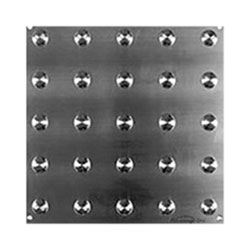









In recent years, tactile walking surface indicators (TWSIs) have become integral to creating accessible public spaces in Canada. It helps visually impaired individuals navigate unfamiliar surrounding safely and confidently. But what exactly are TWSIs, and how do they enhance accessibility? This blog comprehensively introduces TWSIs - their purpose, different types, key applications, and benefits.
Tactile walking surface indicators (TWSIs) refer to textured ground surfaces that provide vital navigational cues to pedestrians who are blind or visually impaired. They consist of standardized distinguishable patterns installed on sidewalks, transit platforms, building entrances, and other walking areas.
TWSIs feature unique surface textures comprising raised domes and bars. These tactile textures are easily discernible underfoot or by using a cane. They convey essential information to pedestrians with visual disabilities about their surroundings and any upcoming hazards or direction changes.
TWSIs are mandated in public spaces as per accessibility legislation like the Accessibility for Ontarians with Disabilities Act (AODA). They provide an invaluable sensory communication channel between infrastructure and individuals with vision loss.
There are two main types of TWSIs:
These indicate potential hazards ahead, like stairs, platform edges, intersections, or boarding zones. The typical texture is truncated domes in a square or radial pattern. They alert pedestrians to stop, assess the environment and proceed with caution.
These provide directional cues along appropriate pathways of travel. Common textures are raised parallel bars or grooved lines along the walking direction. They guide pedestrians along designated pedestrian routes.
Tactile walking surface indicators are utilized in various indoor and outdoor locations:
TWSIs provide immense benefits by enhancing accessibility and safety:
When specifying TWSIs, consider the following:
The two main types are attention/warning TWSIs that indicate hazards and guidance/wayfinding TWSIs that provide directional cues.
TWSIs are required at sidewalks, building entrances, transit platforms, pedestrian crossings, stairs, parks, lobby areas, and other public spaces.
They provide tactile cues that enable people with visual disabilities to detect potential hazards, navigate safely, and orient themselves within environments.
Common materials are metal alloys, engineered polymers, porcelain, rubber, and composite plastics.
At Tactile Solutions, we offers a wide selection of code-compliant TWSIs from trusted brands like:
Our TWSIs are engineered to be long-lasting, safe, and AODA/CSA compliant. With options tailored to every application, we help create accessible spaces that accommodate all users. Contact our experts today for ideal TWSIs that meet your project's unique specifications!
